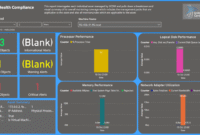What Buyers Really Look for in Business Intelligence Platforms is a crucial topic as organizations strive to harness data effectively. In an age where data-driven decisions shape business success, understanding the key features and functionalities that influence buyer choices is essential. This overview sheds light on the critical factors that buyers consider when evaluating business intelligence solutions, ensuring that their investments lead to actionable insights and strategic advantages.
From user-friendly interfaces to robust analytical capabilities, the landscape of business intelligence platforms is diverse and constantly evolving. Buyers need to navigate this complexity while considering their unique organizational needs, making it imperative to delve into what truly matters in these platforms.
In today’s fast-paced world, the significance of effective communication cannot be overstated. Clear and concise messaging is essential, whether in personal relationships, professional settings, or digital interactions. This comprehensive article explores the various dimensions of communication, including its definition, importance, types, barriers, and strategies to enhance one’s communication skills.
### Understanding Communication
Communication is the process of exchanging information, thoughts, ideas, and feelings between individuals or groups. It can occur through various channels, including verbal, non-verbal, written, and visual methods. The essence of communication lies in its ability to convey messages effectively, fostering understanding and connection among people.
### Importance of Communication
Effective communication is fundamental to numerous aspects of life. Here are some key reasons why communication is vital:
1. Building Relationships: Good communication fosters trust and strengthens relationships, whether personal or professional. By expressing thoughts and feelings clearly, individuals can avoid misunderstandings and develop deeper connections.
2. Facilitating Collaboration: In a workplace setting, effective communication promotes teamwork and collaboration. Team members can share ideas, provide feedback, and work towards common goals more efficiently.
3. Enhancing Problem-Solving: Clear communication is crucial for identifying and resolving issues. By articulating problems and discussing potential solutions, individuals can work together to find effective outcomes.
4. Boosting Engagement: In educational settings, effective communication can increase student engagement. When teachers communicate clearly and encourage dialogue, students are more likely to participate actively in their learning.
5. Influencing Change: Whether advocating for social justice or leading a corporate initiative, effective communication can drive change by persuading others to understand and support a cause.
### Types of Communication
Communication can be categorized into several types, each serving different purposes:
1. Verbal Communication: This includes spoken words and the tone of voice. It is essential in face-to-face interactions, meetings, and presentations.
2. Non-Verbal Communication: Body language, facial expressions, gestures, and eye contact all contribute to non-verbal communication. These cues can enhance or contradict verbal messages.
3. Written Communication: Emails, reports, text messages, and social media posts fall under written communication. It allows for documentation and can be revisited as needed.
4. Visual Communication: Charts, graphs, infographics, and videos convey information visually. This type of communication can simplify complex data and make it more accessible.
### Barriers to Effective Communication
Despite its importance, several barriers can hinder effective communication:
1. Language Barriers: Differences in language or jargon can lead to misunderstandings. It’s crucial to use clear and accessible language, especially in diverse settings.
2. Cultural Differences: Cultural norms and values influence communication styles. Being aware of these differences can help individuals navigate potential conflicts.
3. Emotional Barriers: Personal feelings, such as anger or anxiety, can impact how messages are received. It’s essential to manage emotions to communicate effectively.
4. Physical Barriers: Environmental factors like noise or distance can disrupt communication. Choosing appropriate settings for conversations can mitigate these issues.
5. Perceptual Barriers: Individual perceptions and biases can distort messages. Being open-minded and considering different viewpoints can enhance understanding.
### Strategies for Improving Communication Skills
Improving communication skills takes practice and awareness. Here are some strategies to consider:
1. Active Listening: Effective communication is as much about listening as it is about speaking. Practicing active listening involves fully concentrating on the speaker, understanding their message, and responding thoughtfully.
2. Clarity and Brevity: Aim to be clear and concise in your messages. Avoid unnecessary jargon and focus on delivering your point in an easily understandable manner.
3. Use of Open-Ended Questions: Encourage dialogue by asking open-ended questions. This approach invites the other person to share their thoughts and feelings, fostering a deeper conversation.
4. Non-Verbal Awareness: Pay attention to your non-verbal cues and those of others. Ensure your body language aligns with your verbal messages to avoid mixed signals.
5. Emotional Intelligence: Developing emotional intelligence can enhance your communication skills. Being aware of your emotions and those of others allows for more empathetic interactions.
6. Feedback: Encourage and be open to feedback about your communication style. Constructive criticism can provide valuable insights into areas for improvement.
7. Practice Empathy: Try to understand the perspectives and feelings of others. Empathy can bridge gaps in communication and foster a supportive environment.
8. Adjusting Communication Styles: Adapt your communication style to suit different audiences. This flexibility can improve understanding and engagement.
### Conclusion
In conclusion, effective communication is an essential skill that impacts various areas of life. By understanding its importance, types, barriers, and strategies for improvement, individuals can enhance their ability to connect with others. Whether in personal relationships or professional environments, honing communication skills can lead to more meaningful interactions, improved collaboration, and successful outcomes. Embracing these principles will not only benefit individuals but also contribute to creating a more understanding and cohesive society.
In summary, the landscape of business intelligence platforms is as dynamic as the data they analyze. Understanding what buyers really look for is not just about features; it’s about aligning those features with organizational goals and user needs. As the demand for insightful data continues to grow, staying informed about these preferences will empower buyers to make strategic decisions that lead to greater efficiency and success.
User Queries: What Buyers Really Look For In Business Intelligence Platforms
What are the key features buyers prioritize in BI platforms?
Buyers often prioritize features such as user-friendliness, advanced analytics capabilities, integration with existing systems, customization options, and robust security measures.
How important is customer support when selecting a BI platform?
Customer support is crucial; effective support can significantly enhance the user experience and ensure that any issues are resolved promptly.
Are there specific industries that require tailored BI solutions?
Yes, industries like healthcare, finance, and retail often have unique data requirements and regulatory standards, necessitating specialized BI solutions.
How can businesses ensure they select the right BI platform?

Conducting thorough research, seeking user reviews, and considering pilot programs can help businesses identify the BI platform that best fits their needs.
What role do data visualization tools play in BI platforms?
Data visualization tools are essential as they enable users to easily interpret complex data sets, making insights more accessible and actionable.


